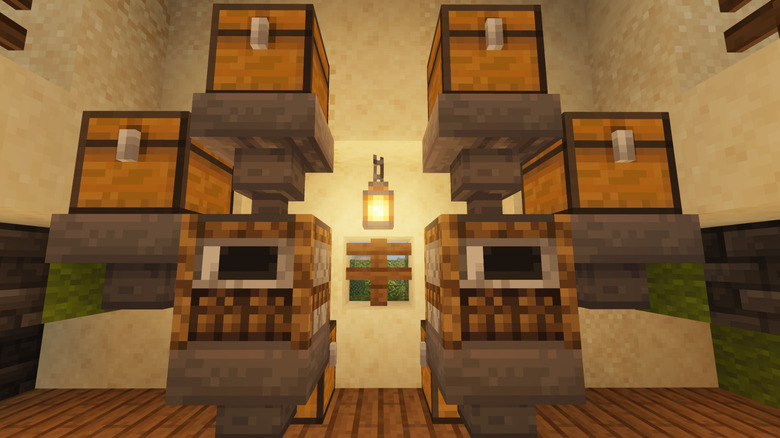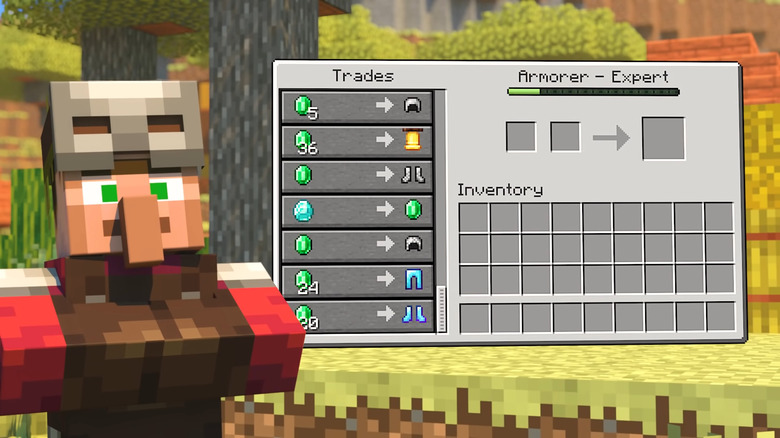The Best Way To Farm XP In Minecraft
Experience points are a somewhat finicky resource to gather in "Minecraft" — manifesting as orbs that absorb into the player that appear like dropped items, XP is rewarded based on interactions with passive and hostile mobs, as well as a couple of item processing functions like smelting or mining certain nodes. The amount awarded varies per method, of course, and there is a different cost-to-effectiveness ratio that fluctuates wildly between sources.
While XP has little to no effect on the process of building, it's an essential part of gear upgrading and upkeep that can't be ignored on survival worlds. As with most farms with more complicated mechanics — like iron farming or slime farming — there are many ways to harvest a reliable supply of XP. The best method is simply what works best for your personal playstyle, and what resources are available. Obviously, players just starting out on a new world won't be able to build the efficient — but dangerous — mob farms. Similarly, established late-game players will get diminishing returns from more simplistic farming methods. Here's a breakdown of the safest to most efficient methods of farming XP in "Minecraft," separated into categories of using item smelting, villager trades, and hostile mobs.
How to farm XP with smelting
Farming XP via smelting items is entirely player-directed and requires no fussing with often-uncooperative AI. The downside is that these methods aren't very efficient, require a steady supply of raw materials, and present the issue of what to do with the processed items after harvesting the XP. They also can't be automated on a larger scale, as the smelted items won't award XP unless manually collected.
But for players who end up spending lots of time occupied with other tasks, these are perfect to have going in the background. Picking which item to smelt, however, requires carefully considering the pros and cons of each:
- Cacti are an easily farmable resource that give as much XP as smelting diamonds (one point, "Java Edition" only), but the resulting green dye has zero utility.
- Any food item is moderately efficient at 0.35 points per item and has universal utility as a food source — baked potatoes in particular double as compostable bonemeal material.
- Kelp and wood are smelted into fuel that can be fed right back into the process for zero surplus hassle, but give the lowest amounts of XP, with wood at 0.15 and kelp at 0.1 points. Kelp's lower output is offset by how easy it is to farm compared to wood, which requires complicated TNT-enabled setups (though the introduction of bamboo — which is even easier to farm than kelp — as a valid wood type in 1.20 might change things).
How to farm XP using villagers
Each trade with a villager awards three to six experience points, with an average of 12 trades enabled for each item in their inventory — factor in their twice-daily restocks, and you can farm a hefty chunk of XP from trading one type of item with even a small gathering of villagers. Here are a few easy options for trading, from best to worst:
- Toolsmiths and Weaponsmiths will trade for iron ingots — which can be farmed from day one — at a great rate of four per trade.
- Farmers will initially buy any of the four base crops, then pumpkins after a level up at six per trade, which is a great rate for an easily automated farmable resource.
- Priests will initially buy rotten flesh at 32 per trade, which isn't a terrible rate when paired with a zombie farm. The priest also sells bottles o' enchanting, which award 3-11 points per bottle.
- Cartographers will buy paper (24 per trade, easily sourced from automated sugarcane farms) and glass panes (11 per trade, easy pickings for players near deserts).
- Fletchers will buy sticks, then feathers and string later on at slightly wasteful rates.
- Shepherds will buy a handful of dyes from a list of possible ones upon leveling up. While getting red or green dye and pairing it with an iron farm's byproduct poppies or a cactus smelting farm can be helpful, actually procuring these inventories relies heavily on luck and might not be worth the effort.
How to farm XP using hostile mobs
If you want lots of XP right away, hostile mob farms are the way to go. The caveat is that all of them either requires finding a spawner block, or building an extensive setup to exploit natural spawns — not to mention the inherent danger of getting killed while building.
Furthermore, not all hostile mob farms are made the same, and some are even outpaced by passive farms. It's important to consider the pros and cons of each type:
- Overworld spawners are relatively common and easy to make farms around, but aren't very efficient and are easily outperformed by mid-game trading farms.
- Blaze spawners are somewhat hard to find and dangerous to build (as the Blazes don't stop spawning regardless of light level), but drop Blaze Rods for brewing potions as well as a good chunk of XP.
- Piglin Gold farms vary in complexity and efficiency, with the high-level designs requiring Nether roof access and tons of scaffolding — but due to how easy it is to manipulate piglin spawns in the Nether, these can have extremely high spawn rates with huge XP outputs for a moderate amount of build difficulty.
- Guardian farms operate on similar principles to gold farms and usually require tons of scaffolding as well as portals or some other complex system to ferry the Guardians to the killzone. However, these spit out XP faster than the player is able to absorb, and outstrip many other more complicated late-game alternatives like Enderman farms.
Things to remember
There are so many ways to farm XP in "Minecraft" that there is no "best" way, per se, so much as methods that are best suited for different purposes. Easy and accessible farms like zombie farms and kelp farms are ideal for the early game before moving onto more efficient upgrades. Setting up a modest trading hall with your preferred selection of villager professions is great for those who need the occasional repair or enchanting (note that the "one emerald trading" or "zombie villager discount" designs only work on Hard difficulty due to how zombie-villager interactions differ). Blaze farms are perfect for the mid-game grind and stocking up on potions. Guardian farms and extensive gold farms are the best options when spamming enchantments to roll specific enhancements — and despite the daunting mechanics, there are quite a few low-difficulty builds out there that don't compromise on efficiency.
That's not to say that only high-end hostile mob farms are viable for end-game XP, either. Smelting farms can be upscaled through sheer quantity, and villager trading can be used as infinite XP spam farms once you have access to the End dimension to mess with their restock algorithm. When it comes down to it, the "best" way to farm XP is entirely up to you assessing your own resources and needs to pick the ideal balance of cost, difficulty, and output for your "Minecraft" world.





